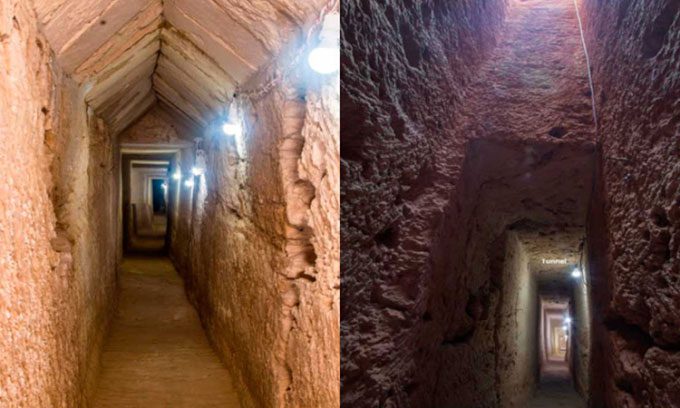The tunnel is located 13 meters below the Taposiris Magna temple area, which may hold the tomb of Queen Cleopatra.
The Egyptian Ministry of Tourism and Antiquities announced an astonishing discovery of a rock-cut tunnel deep beneath the Taposiris Magna temple area, west of Alexandria, reported Ancient Origins on November 5. This massive tunnel, described as a “geometric marvel,” stretches over 1,300 meters. This area is also being researched in the search for the lost tomb of the famous Queen Cleopatra.

The tunnel beneath Taposiris Magna. (Photo: Egyptian Ministry of Tourism and Antiquities)
The Dominican archaeological team from the University of San Domingo, led by Dr. Kathleen Martinez, discovered the tunnel at a depth of 13 meters. During the excavation, they also found several pottery jars beneath layers of silt and a rectangular limestone block. Additionally, two plaster statue heads were discovered near the temple, one of which dates back to the Ptolemaic period.
A portion of the tunnel is submerged underwater, reinforcing the theory that the foundations of the Taposiris Magna temple are also underwater. At least 23 earthquakes have occurred along the Egyptian coast from 320 AD to 1303 AD. This explains the collapse and partial submersion of the Taposiris Magna temple.
The architectural design of the newly discovered tunnel resembles the magnificent Eupalinos Tunnel on the island of Samos (Greece). Eupalinos is considered one of the most significant engineering achievements of ancient Greek-Roman times.
Taposiris Magna, meaning “the great tomb of Osiris”, is an ancient city founded by Pharaoh Ptolemy II between 280 and 270 BC. The temple at Taposiris Magna was dedicated to Osiris, whom the Greek leaders in Egypt worshipped.
For the past 14 years, Martínez has led excavations at Taposiris Magna. The discoveries during this time have made her increasingly confident that she is close to finding the lost tomb of Queen Cleopatra VII and her lover Mark Antony.
Behind the Taposiris Magna temple, experts found a cemetery containing numerous mummies in the Greek-Roman style, buried with their faces turned towards the temple. This suggests that the temple could be the burial site of an important royal figure like Cleopatra. Some experts hope that the newly discovered tunnel may bring them closer to finding the tomb of Queen Cleopatra.

















































